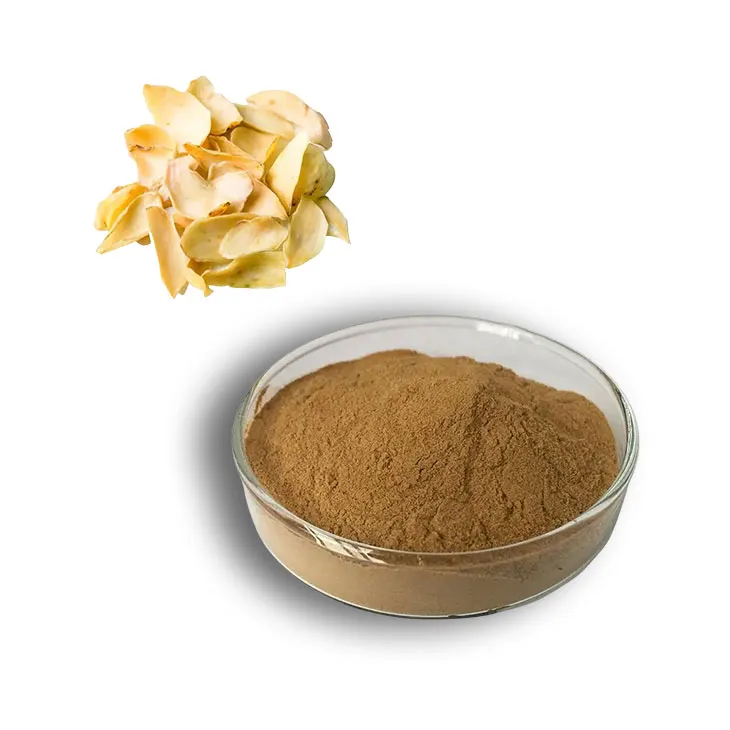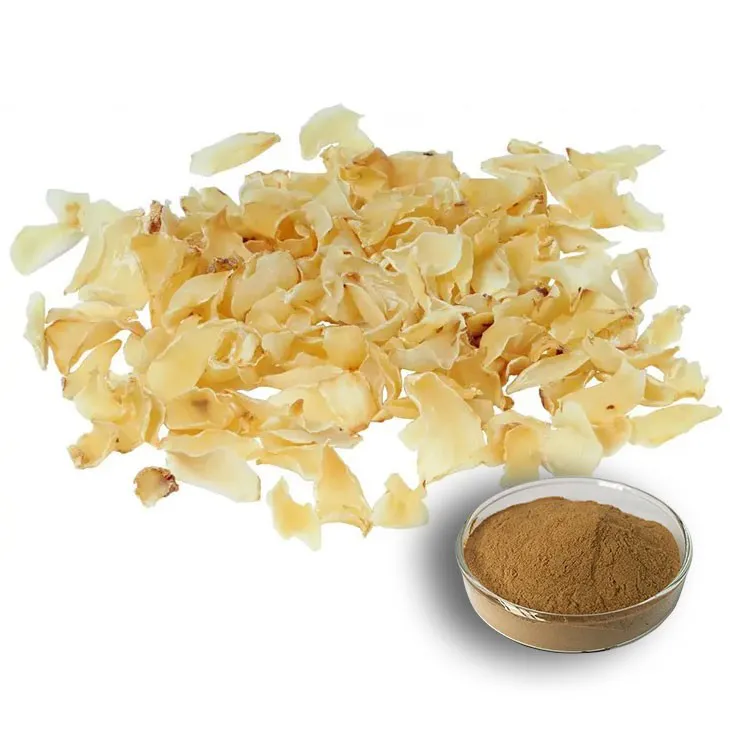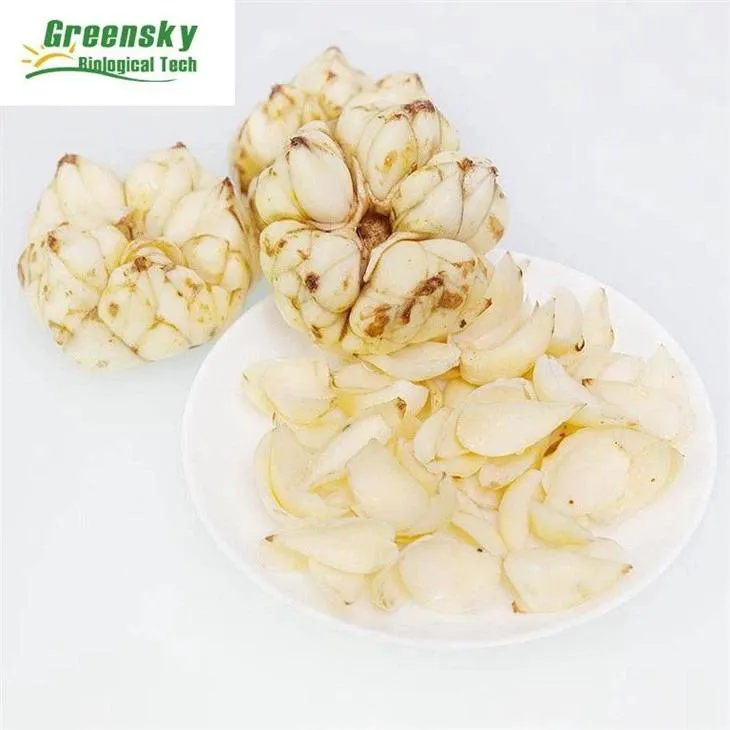- 0086-571-85302990
- sales@greenskybio.com
The process of extracting lily steroidal saponins from lily extract.
2024-11-29

1. Introduction
Lily steroidal saponins are important natural compounds found in lilies. These saponins have attracted significant attention due to their various biological activities, such as anti - inflammatory, antioxidant, and antitumor properties. Therefore, the extraction of lily steroidal saponins from Lily extracts has become an important research area, aiming to obtain these valuable compounds for further applications in pharmaceuticals, cosmetics, and food industries.

2. Significance of Lily Steroidal Saponins
2.1. Pharmaceutical Applications
- Lily steroidal saponins have shown potential in treating various diseases. For example, some saponins have anti - inflammatory effects, which can be used to relieve inflammation - related symptoms in diseases like arthritis. Their antioxidant properties also play a crucial role in preventing oxidative stress - related diseases, such as cardiovascular diseases and neurodegenerative disorders.
- Studies have also indicated that certain lily steroidal saponins may possess antitumor activity. They can potentially inhibit the growth and proliferation of cancer cells, making them promising candidates for cancer treatment or as adjuvants in chemotherapy.
- In the cosmetic industry, lily steroidal saponins are valued for their skin - care benefits. They can help to moisturize the skin, improve skin elasticity, and reduce the appearance of wrinkles. Their antioxidant properties also protect the skin from damage caused by free radicals, which are associated with premature skin aging.
- Some saponins may have anti - microbial properties, which can be used in formulating products for skin cleansing and protection against skin infections.
- Lily steroidal saponins can be used as natural additives in the food industry. They can act as antioxidants to prevent food spoilage and extend the shelf life of food products. Additionally, some saponins may have certain health - promoting effects when consumed, such as improving digestion and enhancing the immune system.

3. Traditional Extraction Methods
3.1. Soxhlet Extraction
- Principle: Soxhlet extraction is a classic method for extracting compounds from solid materials. In the case of lily steroidal saponins extraction from Lily extracts, the lily material is placed in a Soxhlet extractor. The solvent is continuously evaporated and condensed, and the fresh solvent repeatedly washes the lily sample to extract the saponins.
- Solvent Selection: Commonly used solvents for Soxhlet extraction of lily steroidal saponins include ethanol and methanol. Ethanol is often preferred due to its relatively low toxicity and wide availability.
-
Advantages and Disadvantages:
- Advantages: It can achieve relatively high extraction efficiency for compounds with moderate to high solubility in the selected solvent. It is a well - established method and is suitable for large - scale extraction in some cases.
- Disadvantages: The extraction process is time - consuming, usually taking several hours to days. Also, it may require a large amount of solvent, which can be costly and may have environmental impacts.
- Principle: Maceration involves soaking the Lily extract in a solvent for a certain period. During this time, the solvent penetrates the lily material, and the lily steroidal saponins dissolve in the solvent.
- Solvent Selection: Similar to Soxhlet extraction, ethanol and methanol are commonly used solvents. However, water - based solvents can also be considered depending on the solubility characteristics of the saponins.
-
Advantages and Disadvantages:
- Advantages: It is a simple and relatively inexpensive method. It does not require complex equipment and can be carried out in a basic laboratory setting.
- Disadvantages: The extraction time is usually long, often requiring days or even weeks to achieve a satisfactory extraction yield. Moreover, the extraction efficiency may be lower compared to some other methods.

4. Modern Extraction Techniques
4.1. Ultrasonic - Assisted Extraction
- Principle: Ultrasonic - assisted extraction utilizes ultrasonic waves to disrupt the cell walls of the lily material. This disruption enhances the mass transfer of the lily steroidal saponins from the inside of the cells to the solvent, thus increasing the extraction efficiency.
- Solvent Selection: The choice of solvent is similar to traditional methods, with ethanol and methanol being popular options. However, the ultrasonic treatment can sometimes improve the solubility of saponins in solvents, allowing for more flexibility in solvent selection.
-
Advantages and Disadvantages:
- Advantages: It significantly reduces the extraction time compared to traditional methods, usually taking only a few minutes to hours. It also has relatively high extraction efficiency and can be easily combined with other extraction methods or purification steps.
- Disadvantages: The equipment for ultrasonic - assisted extraction can be relatively expensive, especially for high - power ultrasonic devices. Also, improper ultrasonic treatment may cause degradation of some saponins.
- Principle: Microwave - assisted extraction uses microwaves to heat the solvent and lily material rapidly. This rapid heating creates internal pressure within the cells of the lily material, which leads to the rupture of cell walls and the release of lily steroidal saponins into the solvent.
- Solvent Selection: Ethanol and methanol are commonly used solvents. However, the choice may also depend on the dielectric properties of the solvent and the lily material to ensure efficient microwave absorption.
-
Advantages and Disadvantages:
- Advantages: It is a very fast extraction method, usually taking only a few minutes. It has high extraction efficiency and can save a large amount of solvent compared to traditional methods.
- Disadvantages: The microwave - assisted extraction equipment is relatively expensive. There is also a risk of overheating, which may cause the degradation of lily steroidal saponins if not properly controlled.
- Principle: Supercritical fluid extraction uses a supercritical fluid, usually carbon dioxide (CO₂), as the extraction solvent. Supercritical CO₂ has properties between a gas and a liquid, which allows it to penetrate the lily material easily and dissolve the lily steroidal saponins effectively.
- Solvent Selection: CO₂ is the most commonly used supercritical fluid due to its non - toxicity, non - flammability, and easy availability. However, modifiers such as ethanol can be added to improve the solubility of polar saponins.
-
Advantages and Disadvantages:
- Advantages: It is a clean and environmentally friendly extraction method. It can provide high - purity extracts with relatively high extraction efficiency. It also allows for easy separation of the solvent from the extract without leaving any solvent residues.
- Disadvantages: The equipment for supercritical fluid extraction is very expensive, which limits its widespread application. The extraction process also requires precise control of pressure and temperature conditions.

5. Factors Influencing Extraction Efficiency
5.1. Solvent Selection
- The solubility of lily steroidal saponins in different solvents varies. Ethanol and methanol are often used due to their good solubility for saponins. However, the polarity of the solvent should be carefully considered. Polar saponins may require more polar solvents, while non - polar saponins may be better extracted with less polar solvents. Additionally, the safety, cost, and availability of the solvent are also important factors.
- For traditional methods like Soxhlet extraction and maceration, longer extraction times are usually required. However, excessive extraction time may lead to the extraction of unwanted impurities. In modern extraction techniques such as ultrasonic - assisted extraction and microwave - assisted extraction, the extraction time is much shorter, but it still needs to be optimized to ensure maximum extraction efficiency while minimizing the degradation of saponins.
- Temperature has a significant impact on the extraction efficiency. In general, higher temperatures can increase the solubility of saponins in the solvent and accelerate the extraction process. However, for heat - sensitive saponins, high temperatures may cause degradation. Therefore, in methods like microwave - assisted extraction and supercritical fluid extraction where temperature control is crucial, an appropriate temperature range needs to be determined.
6. Purification and Characterization of Extracted Saponins
6.1. Purification
- Column Chromatography: Column chromatography is a commonly used method for purifying lily steroidal saponins. Different types of stationary phases, such as silica gel or reversed - phase materials, can be used depending on the properties of the saponins. The saponin - containing extract is loaded onto the column, and different solvents or solvent mixtures are used to elute the saponins, separating them from impurities.
- Preparative High - Performance Liquid Chromatography (HPLC): Preparative HPLC is a more advanced purification method. It can provide high - resolution separation of saponins. However, it is more expensive and requires more sophisticated equipment compared to column chromatography.
- Structural Characterization: Various spectroscopic techniques are used for structural characterization of lily steroidal saponins. Nuclear Magnetic Resonance (NMR) spectroscopy is one of the most powerful tools for determining the molecular structure of saponins. Infrared (IR) spectroscopy can also provide information about the functional groups present in the saponins. Mass spectrometry (MS) is used to determine the molecular weight and fragmentation pattern of saponins, which helps in identifying their chemical composition.
- Biological Activity Characterization: In vitro and in vivo assays are carried out to characterize the biological activities of the purified lily steroidal saponins. In vitro assays may include antioxidant assays, anti - inflammatory assays, and cytotoxicity assays against cancer cells. In vivo assays can involve animal models to study the effects of saponins on various physiological processes, such as anti - tumor activity in tumor - bearing animals.
7. Conclusion
The extraction of lily steroidal saponins from lily extracts is a complex but important process. Different extraction methods, each with its own advantages and disadvantages, can be used depending on the specific requirements. Factors such as solvent selection, extraction time, and temperature significantly influence the extraction efficiency. After extraction, purification and characterization of the saponins are necessary steps to obtain high - quality and biologically active compounds. This comprehensive understanding of the extraction process will help researchers and industries to better utilize lily steroidal saponins in various fields, including pharmaceuticals, cosmetics, and food industries.
FAQ:
What are the significance of lily steroidal saponins?
Lily steroidal saponins have several important significances. They may possess various biological activities such as antioxidant, anti - inflammatory, and immunomodulatory properties. These saponins also have potential applications in the pharmaceutical industry for the development of new drugs. Additionally, they may play a role in the plant's own defense mechanisms against pests and diseases.
What are the traditional extraction methods for lily steroidal saponins?
Traditional extraction methods for lily steroidal saponins often include solvent extraction. For example, using organic solvents like ethanol or methanol to soak the lily extract. Maceration is a common traditional technique where the plant material is soaked in the solvent for an extended period, allowing the saponins to dissolve into the solvent. Another traditional method could be Soxhlet extraction, which involves continuous refluxing of the solvent through the plant material to extract the saponins more thoroughly.
What are the modern extraction techniques for lily steroidal saponins?
Modern extraction techniques for lily steroidal saponins include ultrasonic - assisted extraction. In this method, ultrasonic waves are applied during the extraction process, which can enhance the mass transfer rate and improve the extraction efficiency. Supercritical fluid extraction is also a modern approach, typically using supercritical carbon dioxide as the solvent. It has the advantages of being environmentally friendly, having a high selectivity, and being able to extract saponins with high purity. Microwave - assisted extraction is another modern technique that uses microwave energy to heat the solvent and plant material rapidly, facilitating the extraction of saponins.
How does solvent selection influence the extraction of lily steroidal saponins?
The choice of solvent has a significant impact on the extraction of lily steroidal saponins. Different solvents have different solubilities for saponins. For example, polar solvents like ethanol and methanol are often effective for Saponin Extraction because lily steroidal saponins are somewhat polar compounds. The polarity of the solvent should match the polarity of the saponins to ensure good solubility. Non - polar solvents may not be as effective in extracting saponins. Additionally, the safety, cost, and availability of the solvent also need to be considered in solvent selection.
How do extraction time and temperature affect the extraction of lily steroidal saponins?
Extraction time and temperature are important factors in the extraction of lily steroidal saponins. Longer extraction times generally increase the amount of saponins extracted up to a certain point. However, if the extraction time is too long, it may lead to the degradation of saponins or the extraction of unwanted impurities. Temperature also plays a role. Higher temperatures can increase the solubility of saponins in the solvent and accelerate the extraction process. But extremely high temperatures may also cause the decomposition of saponins. Therefore, an appropriate balance of extraction time and temperature needs to be found to optimize the extraction efficiency.
Related literature
- Extraction and Bioactivity of Steroidal Saponins from Lilium"
- "Optimization of the Extraction Process of Lily Steroidal Saponins"
- "Characterization of Lily Steroidal Saponins: A Review"
- ▶ Hesperidin
- ▶ Citrus Bioflavonoids
- ▶ Plant Extract
- ▶ lycopene
- ▶ Diosmin
- ▶ Grape seed extract
- ▶ Sea buckthorn Juice Powder
- ▶ Fruit Juice Powder
- ▶ Hops Extract
- ▶ Artichoke Extract
- ▶ Mushroom extract
- ▶ Astaxanthin
- ▶ Green Tea Extract
- ▶ Curcumin
- ▶ Horse Chestnut Extract
- ▶ Other Product
- ▶ Boswellia Serrata Extract
- ▶ Resveratrol
- ▶ Marigold Extract
- ▶ Grape Leaf Extract
- ▶ New Product
- ▶ Aminolevulinic acid
- ▶ Cranberry Extract
- ▶ Red Yeast Rice
- ▶ Red Wine Extract
-
Saponin Extract
2024-11-29
-
Rosemary extract
2024-11-29
-
Cassia Seed Extract
2024-11-29
-
Bayberry Extract
2024-11-29
-
Calendula Extract
2024-11-29
-
Diosmin
2024-11-29
-
Jujube Extract
2024-11-29
-
Dandelion Leaf Extract
2024-11-29
-
Black Pepper Extract
2024-11-29
-
Shikone Extract
2024-11-29





















